5 Best 2 4-D Herbicides In 2025
Broadleaf weeds can transform a pristine lawn into an unsightly mess within weeks. Property owners across the country face constant battles against dandelions, clover, chickweed, and dozens of other invasive plant species that compete with grass for nutrients, water, and sunlight. The solution lies in selective herbicides that target these unwanted plants while preserving the health of your turf.
2,4-D herbicides represent one of the most trusted and effective tools for broadleaf weed elimination. This synthetic auxin mimics natural plant growth hormones, causing targeted weeds to grow uncontrollably until they exhaust their energy reserves and die. The selective nature of 2,4-D means it primarily affects broadleaf plants while leaving grass varieties largely unharmed.
Professional landscapers and homeowners alike rely on these products for consistent results. The key lies in finding the right formulation for your specific needs, application method, and target weeds. This comprehensive review examines five top-performing 2,4-D herbicides currently dominating the market.
Southern Ag Amine 2,4-D Weed Killer: Concentrated Power in Compact Form

The Southern Ag Amine 2,4-D arrives in a convenient 32-ounce container that packs serious punch. This concentrated formula delivers 46.8% 2,4-D dimethylamine salt, making it one of the most potent options available to consumers. The amine formulation reduces volatility compared to ester versions, making it safer for use around sensitive plants.
Application and Coverage
Each quart covers approximately 40,000 square feet when mixed according to label directions. The concentrate requires dilution at rates of 1-2 tablespoons per gallon of water for most broadleaf weeds. This mixing ratio provides excellent value, as a single bottle can treat multiple large properties throughout the growing season.
The low-odor formula makes application more pleasant compared to ester-based alternatives. Users report minimal drift issues when applied during calm weather conditions. The clear liquid mixes easily with water and remains stable in spray tanks for extended periods.
Target Weeds and Effectiveness
Southern Ag excels against common lawn weeds including dandelions, plantain, chickweed, and clover. Field tests demonstrate excellent control of established weeds within 7-14 days of application. Young weeds succumb faster, often showing yellowing and curling within 48 hours.
The product struggles with particularly tough weeds like ground ivy and wild violet. These species may require multiple applications or tank mixing with additional herbicides for complete control. Cool-season application timing proves critical for optimal results.
User Experience
Homeowners appreciate the detailed label instructions and mixing guidelines. The measuring cap simplifies accurate dilution, reducing guesswork that often leads to poor results or plant damage. The concentrated nature means less storage space required compared to ready-to-use products.
Professional applicators value the consistency between batches and reliable performance across different soil types. The product maintains effectiveness in both alkaline and acidic soil conditions, making it suitable for diverse geographic regions.
Hi-Yield 2,4-D Selective Weed Killer: Economy Meets Performance

Hi-Yield offers their 2,4-D formulation in a full gallon container, providing excellent value for large-scale applications. The 30.56% active ingredient concentration balances effectiveness with safety, making it appropriate for both commercial and residential use.
Cost Analysis and Coverage
The gallon size delivers exceptional cost per square foot coverage. When mixed at standard rates, one gallon treats up to 160,000 square feet of turf. This makes Hi-Yield particularly attractive for property management companies, golf courses, and homeowners with extensive lawn areas.
Bulk purchasing advantages extend beyond initial cost savings. Fewer trips to purchase herbicide translates to reduced transportation costs and better inventory management. The larger container also reduces packaging waste compared to multiple smaller bottles.
Formulation Benefits
The amine salt formulation minimizes volatilization, reducing the risk of herbicide drift to nearby gardens or sensitive plantings. This characteristic proves especially valuable in suburban settings where properties sit close together. The reduced vapor pressure also extends the application window during warmer weather.
Temperature stability remains excellent across a wide range of conditions. Users report consistent mixing and application characteristics from near-freezing temperatures up to 85°F. This reliability helps maintain application schedules regardless of weather variations.
Performance Characteristics
Hi-Yield demonstrates solid performance against standard broadleaf weeds. Dandelions, plantain, and broad-leaved dock respond well to single applications when treated during active growth periods. The herbicide translocates effectively through plant systems, ensuring complete kill rather than just top growth burn-down.
Grass safety remains excellent when applied according to label directions. Cool-season grasses like fescue, bluegrass, and ryegrass show minimal stress symptoms. Warm-season varieties including bermudagrass and zoysia tolerate the herbicide well during their active growing periods.
Winfield Shredder 2,4-D Amine 4: Professional-Grade Performance

Winfield positions their Shredder product for serious weed control applications. The 2.5-gallon container size immediately signals this product’s commercial orientation. Professional applicators and large property owners represent the primary target market for this concentrated solution.
Commercial Application Focus
The 4-pound per gallon active ingredient concentration matches or exceeds most competing products. This high concentration allows for lower use rates while maintaining excellent weed control. Professional spray equipment handles the mixing requirements efficiently, making this an ideal choice for commercial operations.
Batch consistency remains critical for commercial applicators who need predictable results across multiple properties. Winfield maintains strict quality control standards, ensuring each container delivers identical performance characteristics. This reliability helps maintain customer satisfaction and reduces callbacks.
Advanced Formulation Technology
The amine formulation incorporates surfactants and penetrating agents that enhance herbicide uptake. These additives improve performance on waxy or hard-to-wet weed species. The enhanced penetration also reduces the impact of light rainfall shortly after application.
pH buffering agents maintain herbicide stability in hard water conditions. Many regions have water supplies with high mineral content that can reduce herbicide effectiveness. The built-in buffering system eliminates the need for additional water conditioning products in most situations.
Efficacy Against Tough Weeds
Shredder excels against problematic species that resist standard herbicide applications. Wild garlic, ground ivy, and wild violet respond well to this concentrated formulation. The enhanced penetration system ensures active ingredient reaches root systems effectively.
Tank mixing compatibility allows applicators to combine Shredder with other herbicides for broader spectrum control. Common combinations include dicamba for enhanced broadleaf control or triclopyr for woody plant suppression. These combinations expand the product’s utility significantly.
Alligare 2,4-D Amine Herbicide: Versatile Solution for Multiple Applications

Alligare produces their 128-ounce 2,4-D formulation with versatility in mind. The gallon container suits both residential and light commercial applications. The 43.5% active ingredient concentration provides excellent potency while maintaining reasonable safety margins.
Multi-Use Applications
Beyond lawn care, Alligare’s formulation works effectively in pasture management, rights-of-way maintenance, and agricultural border treatments. This versatility makes it valuable for rural property owners who need herbicide solutions for multiple applications around their property.
The amine salt formulation reduces environmental concerns compared to ester alternatives. Lower volatility means less risk of herbicide movement to non-target areas. This characteristic proves especially important around livestock operations and organic farming areas.
Mixing and Application Flexibility
The concentrate mixes easily with water at various dilution rates depending on target weeds and application timing. Spot treatments require higher concentrations, while broadcast applications use lower rates for cost-effective coverage. This flexibility allows users to optimize applications for specific situations.
Spray equipment compatibility remains excellent across different application systems. Backpack sprayers, pull-behind units, and truck-mounted systems all handle the diluted product effectively. The low-foam formulation prevents application problems in high-pressure systems.
Environmental Considerations
Alligare emphasizes environmental stewardship in their product development. The herbicide breaks down readily in soil through microbial action, reducing long-term accumulation concerns. Groundwater studies show minimal leaching potential when applied according to label directions.
Wildlife impact studies demonstrate low toxicity to birds and beneficial insects when used properly. The selective nature means minimal impact on desirable flowering plants that support pollinators, provided applicators follow label restrictions regarding blooming weeds.
Liquid Harvest Three-Way Control: Comprehensive Broadleaf Management

Liquid Harvest takes a different approach by combining three active ingredients in their 32-ounce concentrate. The formulation includes 2,4-D, MCPA, and dicamba for enhanced broadleaf weed control. This combination approach targets a broader spectrum of weeds with a single product.
Triple-Action Formula Benefits
The three-way combination attacks weeds through multiple modes of action. While 2,4-D and MCPA both function as synthetic auxins, they affect plants slightly differently. Dicamba adds a third mechanism that proves particularly effective against tough species like ground ivy and wild violet.
Resistance management benefits from the multiple active ingredients. Weeds that might develop tolerance to single-ingredient products face greater pressure from the combination approach. This helps maintain long-term effectiveness across multiple applications.
Enhanced Weed Spectrum
The three-way formula controls over 200 broadleaf weed species according to product labeling. This broad spectrum reduces the need for multiple herbicide products or sequential applications. Property owners can address diverse weed populations with a single treatment program.
Particularly challenging weeds respond better to the combination formula. Species like curly dock, buckhorn plantain, and wild onion show improved control compared to single-ingredient alternatives. The synergistic effects of multiple active ingredients overcome natural plant defenses more effectively.
Application Considerations
The concentrated formula requires careful attention to mixing ratios. The three active ingredients have different dilution requirements that must be balanced for optimal performance. Following label directions precisely ensures proper concentration of each component in the final spray solution.
Spray coverage becomes more critical with combination products. The multiple active ingredients work best with thorough plant coverage that ensures adequate uptake. Users should plan for slightly higher spray volumes compared to single-ingredient applications.
Application Timing and Techniques for Maximum Effectiveness
Successful 2,4-D applications depend heavily on proper timing and technique. Weather conditions, weed growth stage, and grass condition all influence herbicide performance. Understanding these factors helps ensure consistent results while minimizing potential problems.
Optimal Weather Conditions
Temperature ranges between 60-85°F provide ideal conditions for 2,4-D applications. Cooler temperatures slow herbicide uptake and translocation, extending the time needed for visible results. Excessive heat can cause volatilization issues and increase stress on desirable grasses.
Wind speed should remain below 10 mph during application to prevent drift to non-target plants. Early morning or late afternoon applications often provide the calmest conditions. Avoiding midday applications also reduces the risk of herbicide volatilization.
Soil moisture levels affect both herbicide uptake and grass tolerance. Applying to drought-stressed turf increases the risk of grass damage. Light irrigation before treatment ensures plants are actively growing and better able to process the herbicide.
Weed Growth Stage Considerations
Young, actively growing weeds absorb herbicides most effectively. Applications during early spring when weeds are small and tender provide the best control with the lowest herbicide rates. Waiting until weeds mature requires higher rates and may result in incomplete control.
Flowering weeds become more difficult to control as they redirect energy toward seed production. Applications should target weeds before they reach full bloom for optimal results. Post-bloom applications may require higher rates or multiple treatments.
Root development stage influences herbicide translocation. Weeds with well-established root systems transport herbicides more effectively throughout the plant. However, these mature weeds also have greater energy reserves to survive herbicide applications.
Grass Safety and Tolerance
Cool-season grasses tolerate 2,4-D applications best during their active growing periods in spring and fall. Summer applications during heat stress periods increase the risk of temporary yellowing or stunting. Avoiding applications during drought conditions helps maintain grass safety.
Warm-season grasses show excellent tolerance during their peak growing season from late spring through early fall. Applications during dormancy periods or emergence from dormancy can cause temporary discoloration but rarely result in permanent damage.
Newly seeded areas require special consideration. Young grass seedlings are more sensitive to herbicides than established turf. Waiting until after the third mowing before herbicide application reduces the risk of grass injury.
Safety Considerations and Best Practices
2,4-D herbicides require careful handling and application to ensure user safety and environmental protection. Understanding proper safety protocols and following label requirements prevents accidents and reduces liability concerns.
Personal Protective Equipment
Long-sleeved shirts and long pants provide essential skin protection during mixing and application. Chemical-resistant gloves prevent direct contact with concentrated herbicides. Eye protection becomes critical when working with concentrates or during windy conditions.
Respiratory protection may be necessary during large-scale applications or when working in confined areas. Dust masks provide adequate protection for most situations, while respirators may be required for enclosed space applications.
Proper footwear prevents herbicide contact with feet and reduces slip hazards around wet surfaces. Chemical-resistant boots offer the best protection, especially when walking through treated areas shortly after application.
Storage and Handling
Herbicide concentrates require storage in original containers with intact labels. Temperature-controlled storage areas prevent product degradation and container damage. Freezing can affect product performance and container integrity.
Keeping herbicides away from children, pets, and livestock prevents accidental exposure. Locked storage areas provide the best security for herbicide products. Clear labeling helps prevent confusion with other chemicals or household products.
Inventory rotation ensures products remain within their effective lifespan. Most 2,4-D formulations maintain potency for several seasons when stored properly. Regular inventory checks help identify products approaching expiration dates.
Environmental Responsibility
Avoiding applications before heavy rainfall prevents herbicide runoff into water sources. Most labels specify minimum intervals between application and expected precipitation. Following these guidelines protects water quality and maintains herbicide effectiveness.
Buffer zones around wells, streams, and ponds prevent contamination of water supplies. State regulations often specify minimum distances for herbicide applications near water sources. Local environmental agencies can provide specific guidance for sensitive areas.
Proper disposal of empty containers and unused herbicides protects the environment and complies with regulations. Many areas have hazardous waste collection programs that accept pesticide products. Never dispose of herbicides in regular trash or pour them down drains.
Economic Considerations and Value Analysis
Herbicide costs represent a significant portion of lawn care budgets for both homeowners and professionals. Evaluating products based on cost per square foot treated provides more meaningful comparisons than simple container prices.
Cost-Effectiveness Calculations
Concentrate products typically offer better value than ready-to-use formulations. The ability to adjust mixing ratios based on weed pressure allows users to optimize herbicide costs. Light infestations require lower rates, while heavy weed populations need stronger solutions.
Coverage calculations help determine true product value. A more expensive concentrate may provide lower cost per square foot than a cheaper product with lower active ingredient concentration. Factoring in mixing costs and labor helps provide complete cost analysis.
Application frequency affects overall program costs. Products that provide longer-lasting control may cost more initially but require fewer applications throughout the growing season. Extended control reduces labor costs and equipment wear.
Professional vs. Homeowner Considerations
Professional applicators benefit from bulk purchasing and higher concentration products. The ability to buy larger containers reduces per-unit costs significantly. Higher concentration products also reduce transportation and storage costs for commercial operations.
Homeowners may find smaller containers more practical despite higher per-unit costs. Storage limitations and infrequent use make smaller quantities more appropriate. The convenience factor often justifies slightly higher costs for occasional users.
Equipment costs influence product selection decisions. Concentrate products require mixing equipment and accurate measuring devices. Ready-to-use products eliminate mixing requirements but limit application flexibility and increase long-term costs.
Seasonal Application Strategies
Different seasons present unique opportunities and challenges for 2,4-D applications. Understanding seasonal weed growth patterns and grass conditions helps optimize application timing for maximum effectiveness.
Spring Applications
Early spring provides excellent conditions for pre-emergent broadleaf weed control. Many perennial weeds begin active growth as soil temperatures rise, making them susceptible to herbicide applications. Grass competition remains low, allowing weeds to absorb herbicides more effectively.
Soil moisture levels typically remain optimal during spring months. Regular precipitation keeps weeds actively growing while providing the moisture needed for herbicide uptake. However, excessive rainfall can dilute herbicides or cause runoff problems.
Cool temperatures during spring extend the application window for 2,4-D products. Lower volatilization rates reduce drift concerns and allow applications during longer daylight hours. However, cold snaps can slow herbicide activity and delay visible results.
Summer Management
Summer heat stress affects both weed control and grass tolerance. High temperatures increase herbicide volatility and can damage sensitive grass species. Morning applications help minimize heat-related problems while ensuring adequate herbicide uptake.
Drought conditions common during summer months require careful water management. Irrigating before herbicide application ensures weeds are actively growing and better able to absorb herbicides. However, excessive irrigation after application can reduce herbicide effectiveness.
Summer weed populations often include heat-tolerant species that resist herbicide applications. Higher herbicide rates or multiple applications may be necessary for complete control. However, increased rates also raise the risk of grass injury during heat stress.
Fall Opportunities
Fall applications target perennial weeds as they prepare for winter dormancy. Weeds actively transport nutrients to root systems during this period, enhancing herbicide translocation. This makes fall applications particularly effective for controlling deep-rooted perennials.
Cool-season grasses recover quickly from summer stress during fall months. Improved grass vigor helps competition against weeds while reducing the risk of herbicide injury. Fall applications often provide better grass safety compared to summer treatments.
Reduced weed seed production results from successful fall herbicide applications. Eliminating weeds before they produce seeds reduces future weed populations. This preventive approach proves more cost-effective than treating larger weed populations the following season.
Integration with Overall Lawn Care Programs
Effective weed control requires integration with other lawn care practices. Herbicide applications work best when combined with proper fertilization, irrigation, and cultural management techniques.
Fertilization Timing
Coordinating herbicide and fertilizer applications maximizes efficiency while reducing application costs. Many liquid fertilizers mix safely with 2,4-D herbicides, allowing single-pass applications. However, compatibility testing helps prevent tank mixing problems.
Nitrogen fertilization enhances grass competition against weeds. Strong grass growth helps prevent weed establishment and speeds recovery after herbicide applications. Timing nitrogen applications to promote grass growth during peak herbicide effectiveness periods provides synergistic benefits.
Soil testing helps determine optimal fertilization programs that support healthy grass growth. Proper soil pH and nutrient levels enhance grass vigor while potentially affecting herbicide performance. Some herbicides work better in specific pH ranges.
Irrigation Management
Proper irrigation supports healthy grass growth that naturally suppresses weeds. Deep, infrequent watering encourages deep root development in desirable grasses while discouraging shallow-rooted weeds. Timing irrigation to avoid interference with herbicide applications maintains product effectiveness.
Drought stress makes grass more susceptible to herbicide injury while reducing weed control effectiveness. Maintaining adequate soil moisture before and after herbicide applications helps ensure consistent results. However, excessive moisture can promote weed growth and reduce herbicide persistence.
Irrigation system design affects herbicide application uniformity. Poor coverage patterns can result in untreated areas where weeds survive and spread. Regular irrigation system maintenance ensures consistent water distribution that supports uniform grass growth.
Cultural Practices
Mowing practices influence weed control success significantly. Proper mowing height promotes grass density that naturally suppresses weeds. However, mowing too soon after herbicide application can reduce weed control by removing treated plant tissue.
Overseeding helps fill thin areas where weeds typically establish. Dense grass stands provide the best long-term weed prevention. Timing overseeding to avoid conflicts with herbicide applications ensures successful grass establishment.
Soil compaction creates conditions favorable for certain weed species while stressing desirable grasses. Core aeration helps relieve compaction and improve growing conditions for grass. Reducing soil compaction through proper traffic management prevents many weed problems.
Troubleshooting Common Application Problems
Even experienced applicators encounter problems with herbicide applications occasionally. Understanding common issues and their solutions helps maintain consistent weed control results.
Poor Weed Control
Inadequate herbicide rates represent the most common cause of poor weed control. Measuring concentrate accurately ensures proper active ingredient rates. Using graduated mixing containers helps prevent dilution errors that reduce effectiveness.
Application timing affects herbicide uptake and translocation. Treating weeds during periods of slow growth or stress reduces control effectiveness. Monitoring weather conditions and plant growth stages helps optimize application timing.
Spray coverage problems can leave untreated weeds that continue growing. Calibrating spray equipment ensures proper output rates and coverage patterns. Walking speed during application affects coverage uniformity significantly.
Grass Injury
Excessive herbicide rates or inappropriate timing can cause grass injury. Cool-season grasses are most susceptible during summer heat stress periods. Warm-season grasses show sensitivity during cool weather when growth slows.
Spray overlap during application creates areas of double rates that can injure grass. Using spray pattern markers or foam additives helps maintain proper coverage without excessive overlap. GPS guidance systems help professional applicators maintain accurate patterns.
Tank contamination from previous applications can cause unexpected grass injury. Thoroughly cleaning spray equipment between different herbicide types prevents contamination problems. Using tank cleaners helps remove residues that standard rinsing might miss.
Environmental Issues
Herbicide drift to non-target plants causes damage complaints and potential liability issues. Proper nozzle selection and pressure settings minimize drift potential. Weather monitoring helps identify conditions unsuitable for herbicide applications.
Water contamination concerns arise from improper application near water sources or excessive rainfall shortly after treatment. Following label buffer requirements and monitoring weather forecasts helps prevent water quality problems.
Future Trends in 2,4-D Herbicide Technology
Herbicide technology continues evolving to address changing weed populations, environmental concerns, and application challenges. Understanding emerging trends helps users prepare for future product developments.
Enhanced Formulations
Microencapsulation technology provides controlled release of active ingredients that extends herbicide persistence while reducing environmental exposure. These formulations may offer longer-lasting weed control with reduced application frequency.
Adjuvant systems built into herbicide formulations improve uptake and translocation without requiring tank mixing. These systems reduce mixing complexity while ensuring optimal herbicide performance across various conditions.
Drift reduction technologies help minimize off-target movement during application. Polymer additives and specialized nozzle designs reduce droplet drift while maintaining coverage effectiveness.
Precision Application
GPS-guided application systems enable variable rate applications based on weed density mapping. These systems optimize herbicide use while reducing costs and environmental impact. Professional applicators increasingly adopt precision technologies for improved efficiency.
Sensor technologies can identify weed species and growth stages automatically. Future systems may adjust herbicide rates and formulations based on real-time weed identification. This technology could revolutionize selective weed control approaches.
Robotic application systems under development may provide consistent, precise herbicide applications without human operators. These systems could reduce labor costs while improving application accuracy and safety.
Environmental Innovations
Biodegradable formulations break down more rapidly in soil and water systems. These products maintain effectiveness while reducing long-term environmental persistence concerns. Regulatory trends favor products with improved environmental profiles.
Reduced-risk active ingredients may supplement or replace traditional herbicides in some applications. Plant-derived compounds and biological agents offer alternative approaches to synthetic herbicides while maintaining effectiveness.
Integrated pest management systems combine herbicides with cultural, biological, and mechanical control methods. These comprehensive approaches reduce reliance on any single control method while improving long-term weed management.
Conclusion
The five 2,4-D herbicides reviewed represent proven solutions for broadleaf weed control in various applications. Southern Ag provides concentrated power in a convenient size, while Hi-Yield offers excellent value for large-area treatments. Winfield Shredder delivers professional-grade performance for commercial applications, and Alligare provides versatile solutions for multiple uses. Liquid Harvest’s three-way formula addresses the broadest weed spectrum with enhanced effectiveness.
Success with any 2,4-D herbicide depends on proper application timing, appropriate rates, and integration with overall lawn care programs. Environmental conditions, target weeds, and grass species all influence product selection and application strategies. Following label directions and safety protocols ensures effective weed control while protecting human health and environmental resources.
The economics of herbicide applications extend beyond initial product costs to include coverage rates, application frequency, and long-term effectiveness. Professional applicators benefit from concentrated products and bulk purchasing options, while homeowners may prefer smaller containers despite higher per-unit costs.
Seasonal application strategies help optimize herbicide performance while minimizing potential problems. Spring and fall typically provide the best conditions for 2,4-D applications, though summer treatments remain viable with proper precautions. Integration with fertilization, irrigation, and cultural practices enhances overall weed control success.
Future developments in herbicide technology promise improved effectiveness, reduced environmental impact, and enhanced application precision. Staying informed about these trends helps users make better product selections and adopt improved application techniques.
Effective broadleaf weed control remains achievable with current 2,4-D herbicide technology. Proper product selection, application techniques, and program integration provide consistent results while maintaining healthy turf and environmental stewardship. These reviewed products represent reliable options for achieving professional-quality weed control results.







